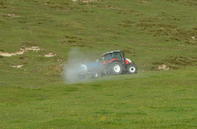Fertilisation of pastures is important, both at the planting stage and also later when maintaining pastures.

The aim with pasture fertilisation is to ensure that a pasture contains the nutrients needed for animal production and produces enough dry matter for feeding livestock. According to agroecology principles, feeding the soil is more important than feeding the crop.
Therefore, the starting point to a fertilising programme should be a proper soil analysis to determine soil properties and nutrient deficiencies/excesses.
Soil pH and Nutrient Availability
The pH scale goes from 0 to 14 with pH 7 as the neutral point. Below pH 7 is acidic and above pH 7 is alkaline. The main aim with the correcting of soil pH is to correct soil acidity as soil pH plays a role in nutrient availability in the soil.
Adding agricultural lime provides the required plant nutrients like calcium and magnesium, it can reduce toxic aluminium levels and increase the availability of phosphorus (P) in the soil. In acid soils of pH lower than 6, the availability of plant-soluble nitrogen is slow.
Also, the availability of the micronutrients manganese (Mn), iron (Fe), copper (Cu), zinc (Zn) and boron (B) tend to decrease as soil pH increases - when soil becomes alkaline. Grasses and legumes are different in their tolerance to soil pH. Grasses can tolerate low pH, although if there is a calcium (Ca) or magnesium (Mg) deficiency, liming of the soil is required.
Legumes require moderate acid to neutral soils to produce a good yield, and for the development of Rhizobium bacteria, which are integral to the nitrogen-fixing process of legumes in the soil.
Agricultural lime applications can vary between calcitic or dolomitic lime and will depend on the deficiency status. Soil pH tends to decrease (acidify) when ammonium-based fertilisers are used or when a high percentage of legumes are planted.
Phosphorus
Phosphorous (P) requirements for grass pastures are often underestimated and although grass pastures can survive on low levels of phosphorous, pasture yield will be below the potential.
Due to the interaction between nitrogen and phosphorous, phosphorus becomes more important when nitrogen is applied to the pasture. Phosphorous is very important for successful production of legumes especially irrigated lucerne pastures.
For example, clovers usually grow in relatively high rainfall areas, where P and agricultural lime applications are often required.
Potassium
When a pasture is grazed, about 90% of Potassium (K) taken up by the grazing stock is recycled back into the soil via the manure and urine. However, if pastures are cut regularly for hay or silage, potassium is removed.
For example, 10 kg of potassium is removed for every ton of weeping love grass (Eragrostics curvula) harvested. Maintain the correct level of potassium in the soil by annual applications.
Nitrogen
Nitrogen (N) is the key to the successful production of grass pastures. In any fertilisation programme, there must be a balance between nitrogen and nutrients like phosphorus and potassium, levels should be correlated to moisture and the type of pasture.
Nitrogen can be applied up to six times and the frequency of application will depend on pasture species, production, length of growing season, weather and where the herd sleeps. Summer-growing pastures use nitrogen more efficiently early in the growing season and it may be advantageous to top-dress accordingly.
Legumes with well-developed Rhizobium nodes require no nitrogen. Should a newly established legume pasture turn yellow, it can mean that the Rhizobium bacteria have not yet started to fix nitrogen from the air or the plant may be suffering from a nitrogen deficiency. A topdressing of nitrogen can overcome this problem.
Trace Elements
A deficiency of trace elements especially molybdenum (Mo) can inhibit optimal production of legumes, but can easily be adjusted. A soil test and advice from an agricultural advisor is recommended.
Please note: Information is for educational and informational purposes only and may not be construed as fertilisation advice. For more information on feeding your soil and fertilisation of pastures contact your agricultural technician or supplier.
Source Water Research Commission